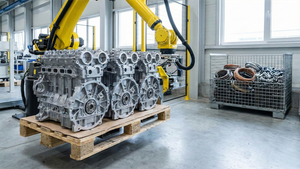
Industrials automation company Rockwell (NYSE: ROK) missed Wall Street’s revenue expectations in Q4 CY2024, with sales falling 8.3% year on year to $1.88 billion. Its non-GAAP profit of $1.83 per share was 16% above analysts’ consensus estimates.
Is now the time to buy Rockwell Automation? Find out by accessing our full research report, it’s free.
Rockwell Automation (ROK) Q4 CY2024 Highlights:
- Revenue: $1.88 billion vs analyst estimates of $1.89 billion (8.3% year-on-year decline, 0.6% miss)
- Adjusted EPS: $1.83 vs analyst estimates of $1.58 (16% beat)
- Adjusted EBITDA: $286 million vs analyst estimates of $311.3 million (15.2% margin, 8.1% miss)
- Management reiterated its full-year Adjusted EPS guidance of $9.20 at the midpoint
- Operating Margin: 17.1%, up from 13.7% in the same quarter last year
- Free Cash Flow was $293 million, up from -$35.3 million in the same quarter last year
- Organic Revenue fell 7.6% year on year (1% in the same quarter last year)
- Market Capitalization: $30.34 billion
"Q1 margins and EPS came in well above our expectations this quarter, reflecting some early benefits of Rockwell’s renewed focus on operational excellence and cost discipline. We continue to deliver on our cost reduction and margin expansion projects we outlined last year. From a demand perspective, we are encouraged by better-than-expected order performance in the quarter with sequential growth across all regions and business segments. While there is still some macroeconomic and policy uncertainty weighing on customers’ capex plans, Rockwell won multi-million dollar strategic orders across key industries, especially in the U.S., our home market," said Blake Moret, Chairman and CEO.
Company Overview
One of the first companies to address industrial automation, Rockwell Automation (NYSE: ROK) sells products that help customers extract more efficiency from their machinery.
Internet of Things
Industrial Internet of Things (IoT) companies are buoyed by the secular trend of a more connected world. They often specialize in nascent areas such as hardware and services for factory automation, fleet tracking, or smart home technologies. Those who play their cards right can generate recurring subscription revenues by providing cloud-based software services, boosting their margins. On the other hand, if the technologies these companies have invested in don’t pan out, they may have to make costly pivots.
Sales Growth
A company’s long-term sales performance signals its overall quality. Even a bad business can shine for one or two quarters, but a top-tier one grows for years. Over the last five years, Rockwell Automation grew its sales at a sluggish 3.7% compounded annual growth rate. This fell short of our benchmark for the industrials sector and is a rough starting point for our analysis.
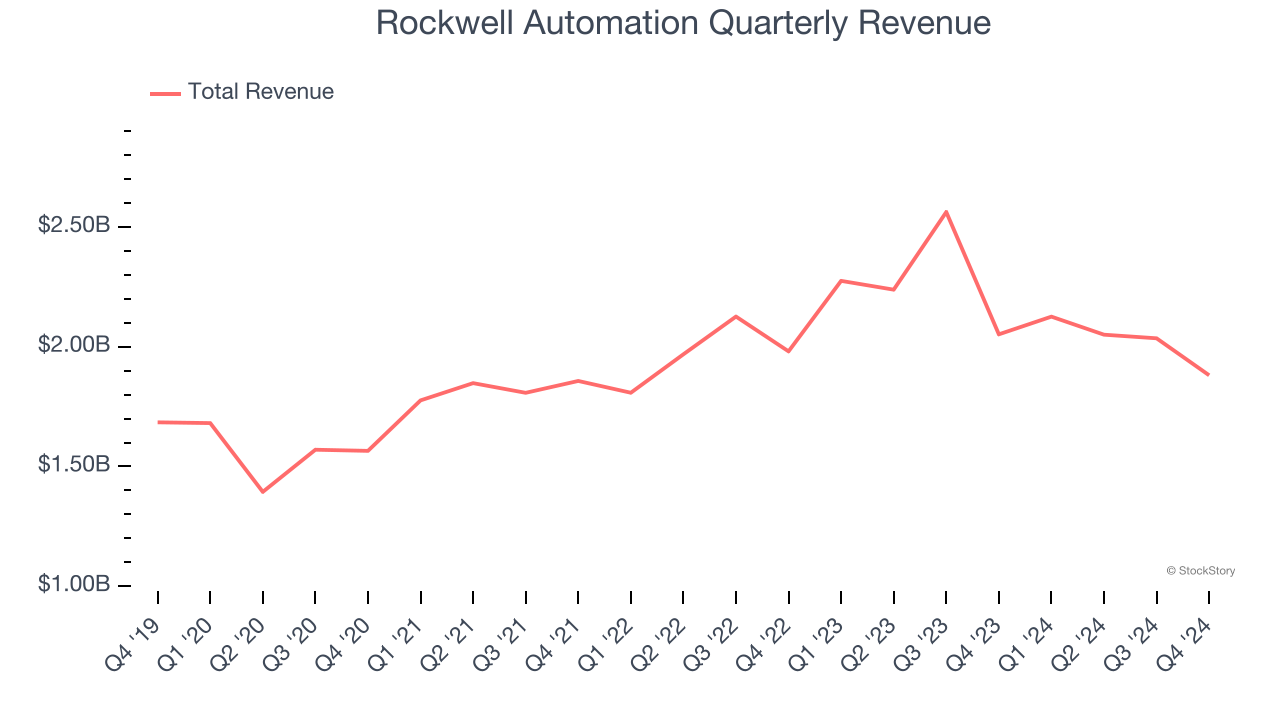
Long-term growth is the most important, but within industrials, a half-decade historical view may miss new industry trends or demand cycles. Rockwell Automation’s recent history shows its demand slowed as its annualized revenue growth of 1.3% over the last two years is below its five-year trend. 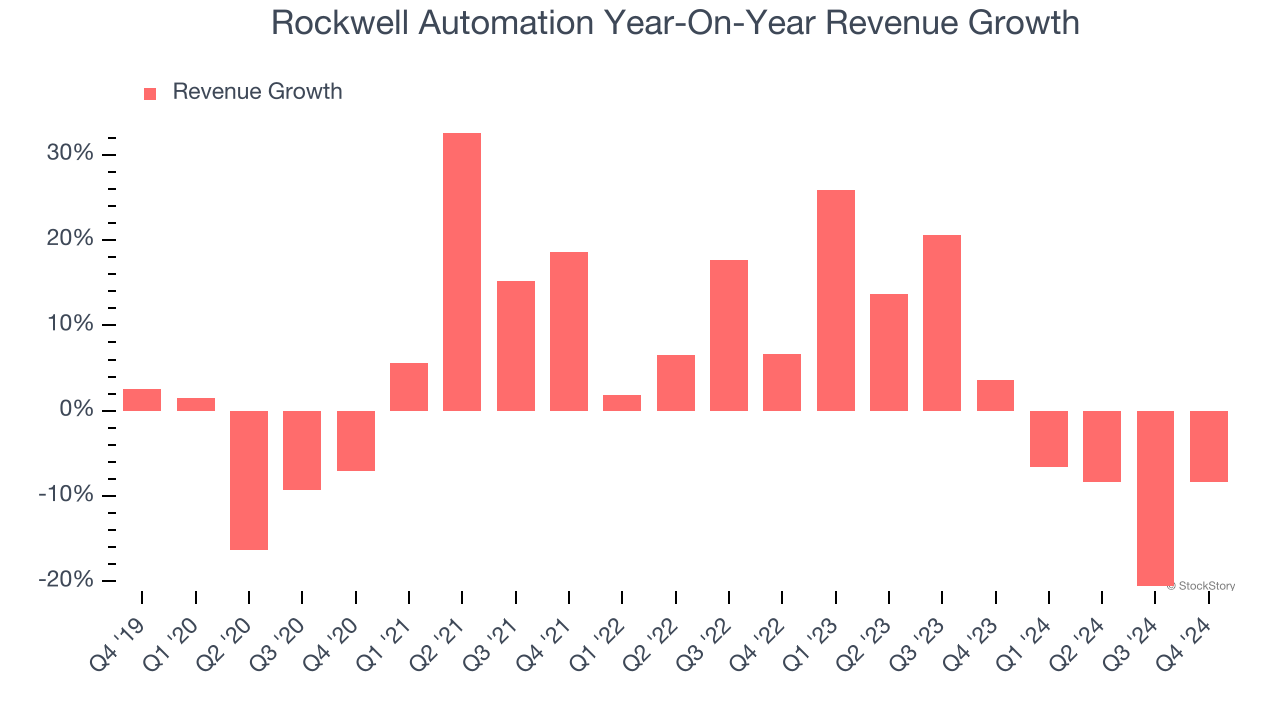
We can dig further into the company’s sales dynamics by analyzing its organic revenue, which strips out one-time events like acquisitions and currency fluctuations that don’t accurately reflect its fundamentals. Over the last two years, Rockwell Automation’s organic revenue averaged 1.7% year-on-year growth. Because this number aligns with its normal revenue growth, we can see the company’s core operations (not acquisitions and divestitures) drove most of its results. 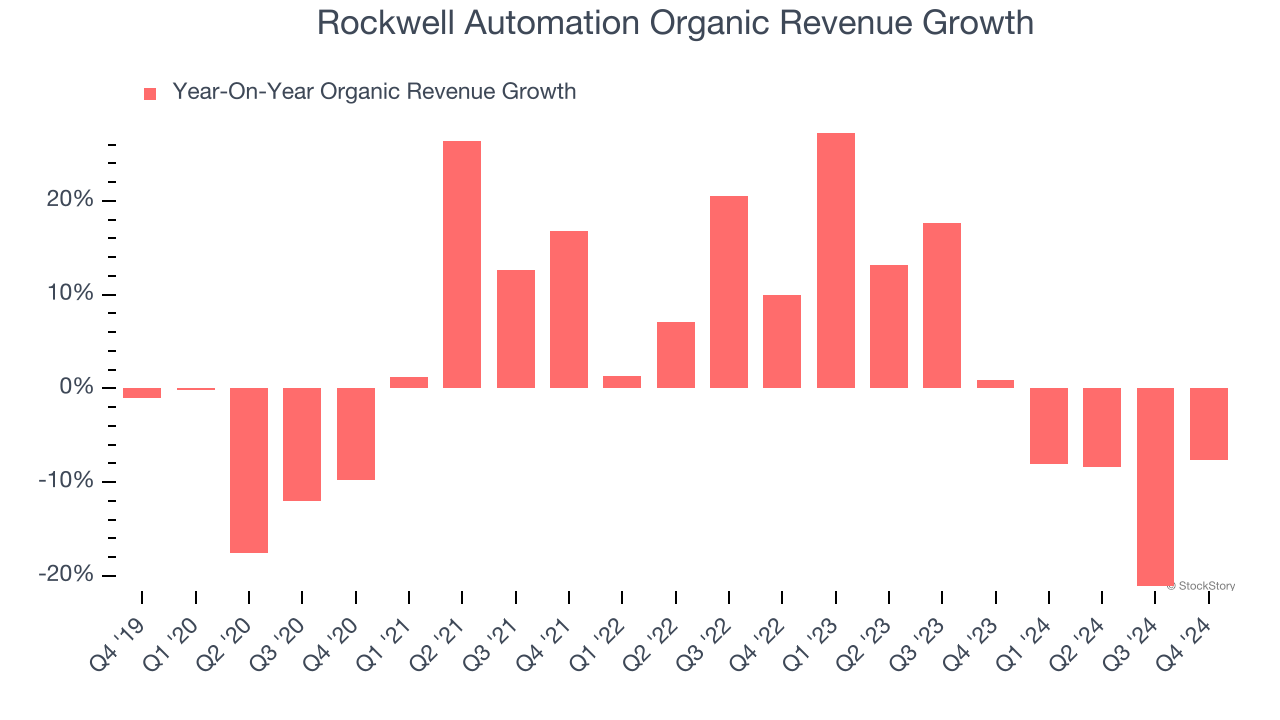
This quarter, Rockwell Automation missed Wall Street’s estimates and reported a rather uninspiring 8.3% year-on-year revenue decline, generating $1.88 billion of revenue.
Looking ahead, sell-side analysts expect revenue to grow 2.1% over the next 12 months, similar to its two-year rate. This projection is underwhelming and implies its newer products and services will not lead to better top-line performance yet.
Today’s young investors won’t have read the timeless lessons in Gorilla Game: Picking Winners In High Technology because it was written more than 20 years ago when Microsoft and Apple were first establishing their supremacy. But if we apply the same principles, then enterprise software stocks leveraging their own generative AI capabilities may well be the Gorillas of the future. So, in that spirit, we are excited to present our Special Free Report on a profitable, fast-growing enterprise software stock that is already riding the automation wave and looking to catch the generative AI next.
Operating Margin
Operating margin is an important measure of profitability as it shows the portion of revenue left after accounting for all core expenses – everything from the cost of goods sold to advertising and wages. It’s also useful for comparing profitability across companies with different levels of debt and tax rates because it excludes interest and taxes.
Rockwell Automation has been a well-oiled machine over the last five years. It demonstrated elite profitability for an industrials business, boasting an average operating margin of 17%. This result isn’t surprising as its high gross margin gives it a favorable starting point.
Looking at the trend in its profitability, Rockwell Automation’s operating margin decreased by 2.3 percentage points over the last five years. Even though its historical margin is high, shareholders will want to see Rockwell Automation become more profitable in the future.
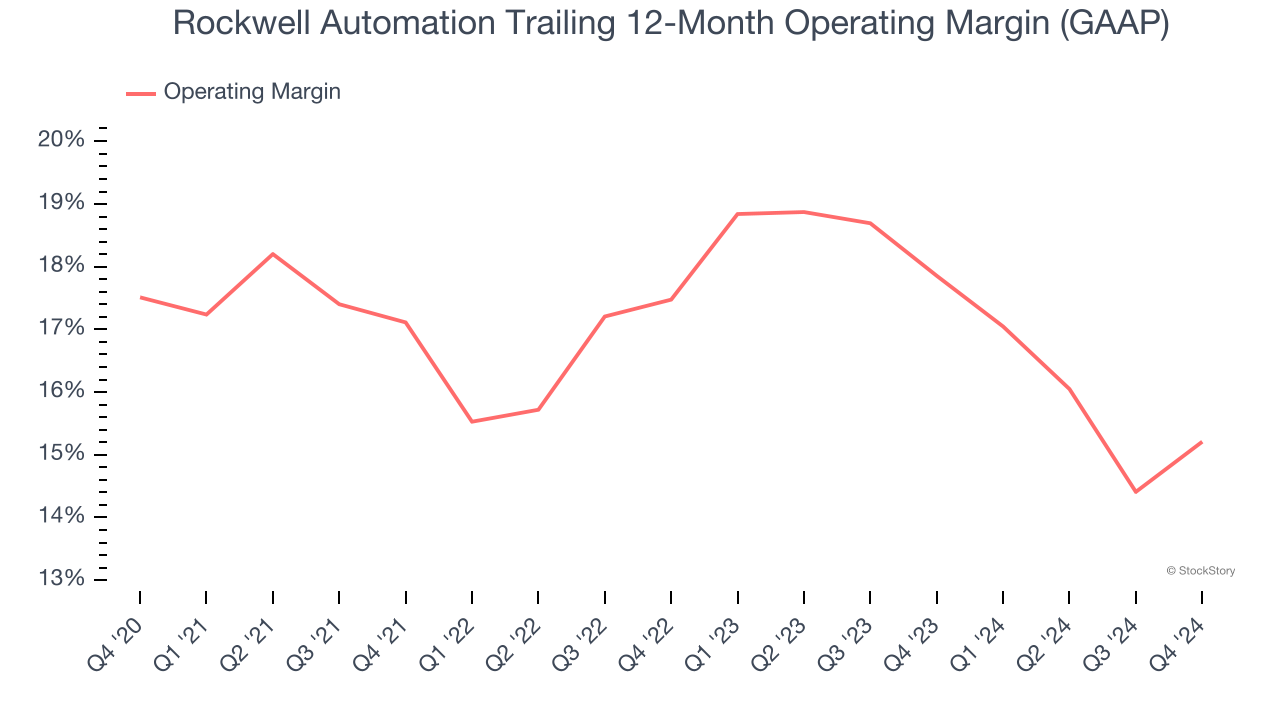
In Q4, Rockwell Automation generated an operating profit margin of 17.1%, up 3.4 percentage points year on year. The increase was encouraging, and since its operating margin rose more than its gross margin, we can infer it was recently more efficient with expenses such as marketing, R&D, and administrative overhead.
Earnings Per Share
Revenue trends explain a company’s historical growth, but the long-term change in earnings per share (EPS) points to the profitability of that growth – for example, a company could inflate its sales through excessive spending on advertising and promotions.
Rockwell Automation’s EPS grew at a weak 1.8% compounded annual growth rate over the last five years, lower than its 3.7% annualized revenue growth. This tells us the company became less profitable on a per-share basis as it expanded due to non-fundamental factors such as interest expenses and taxes.
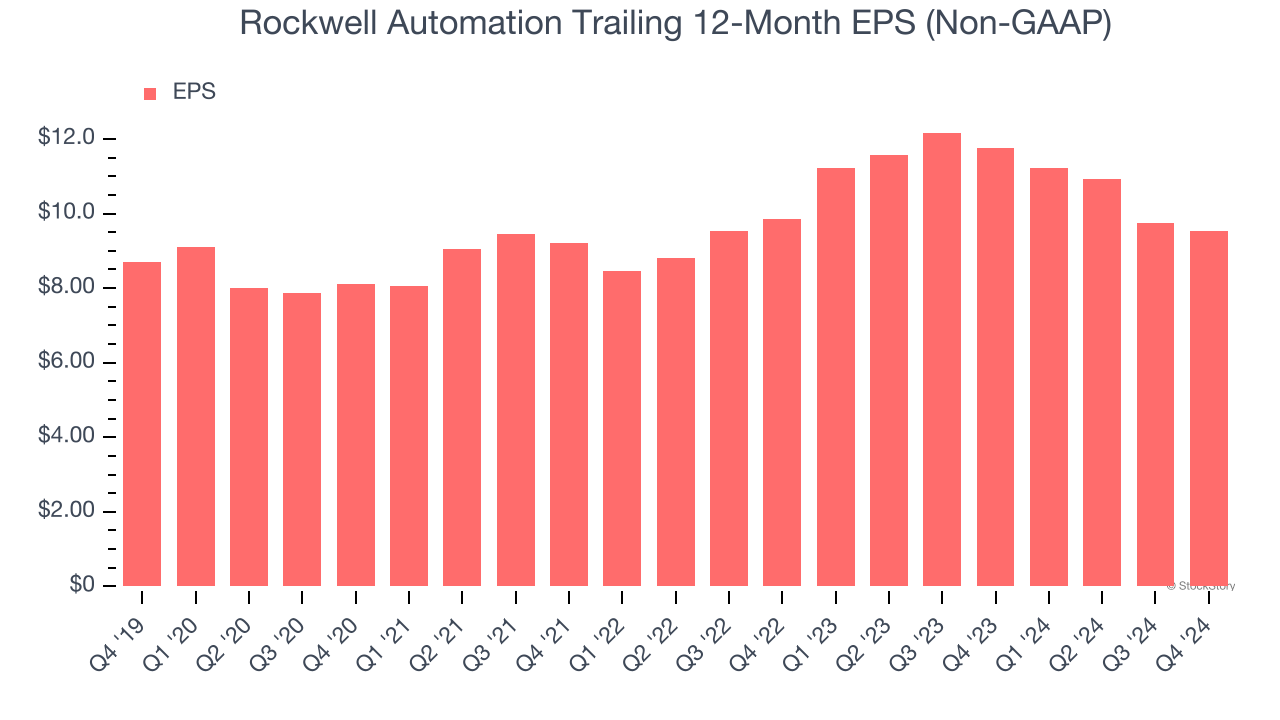
We can take a deeper look into Rockwell Automation’s earnings to better understand the drivers of its performance. As we mentioned earlier, Rockwell Automation’s operating margin improved this quarter but declined by 2.3 percentage points over the last five years. This was the most relevant factor (aside from the revenue impact) behind its lower earnings; taxes and interest expenses can also affect EPS but don’t tell us as much about a company’s fundamentals.
Like with revenue, we analyze EPS over a more recent period because it can provide insight into an emerging theme or development for the business.
For Rockwell Automation, its two-year annual EPS declines of 1.7% show it’s continued to underperform. These results were bad no matter how you slice the data.
In Q4, Rockwell Automation reported EPS at $1.83, down from $2.05 in the same quarter last year. Despite falling year on year, this print easily cleared analysts’ estimates. Over the next 12 months, Wall Street expects Rockwell Automation’s full-year EPS of $9.53 to grow 2.7%.
Key Takeaways from Rockwell Automation’s Q4 Results
We enjoyed seeing Rockwell Automation exceed analysts’ EPS expectations this quarter. On the other hand, its revenue fell slightly short of Wall Street’s estimates. Looking ahead, the company reiterated its full-year EPS guidance, showing that things are roughly on track despite some beats and misses in the quarter. Overall, results were mixed, but it seems that the quarter cleared the market's expectations. The stock traded up 6.2% to $284.80 immediately after reporting.
So should you invest in Rockwell Automation right now? What happened in the latest quarter matters, but not as much as longer-term business quality and valuation, when deciding whether to invest in this stock. We cover that in our actionable full research report which you can read here, it’s free.




